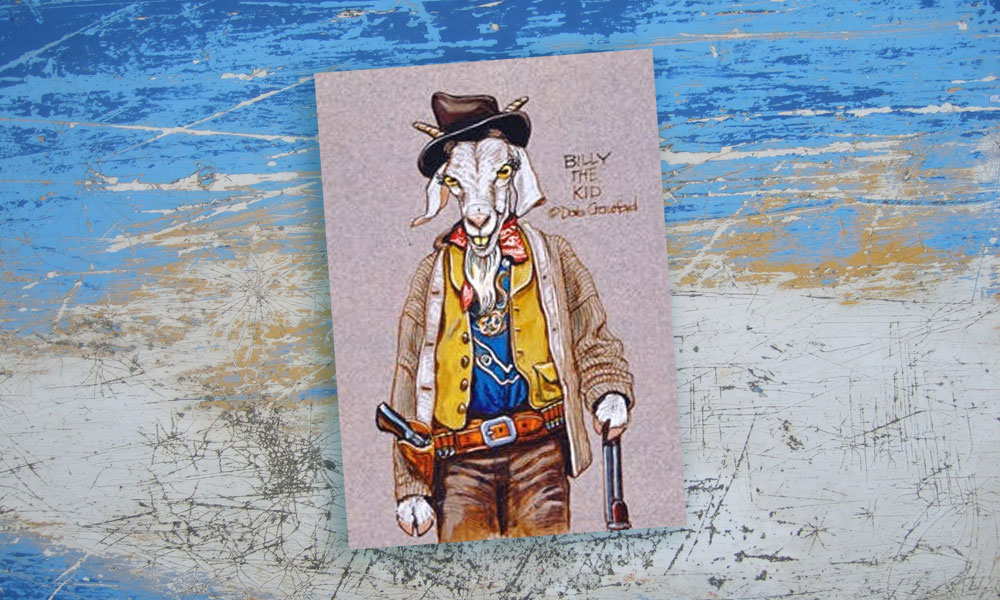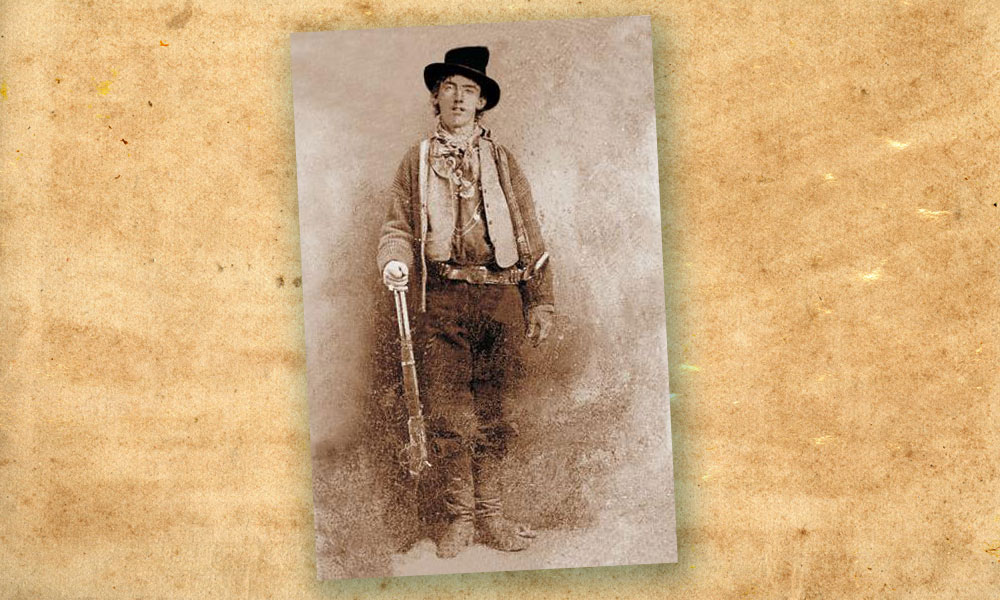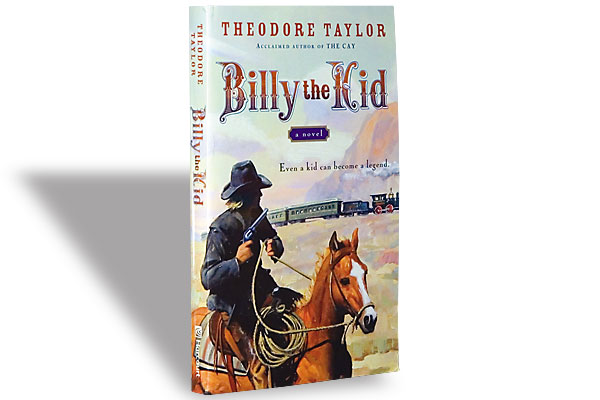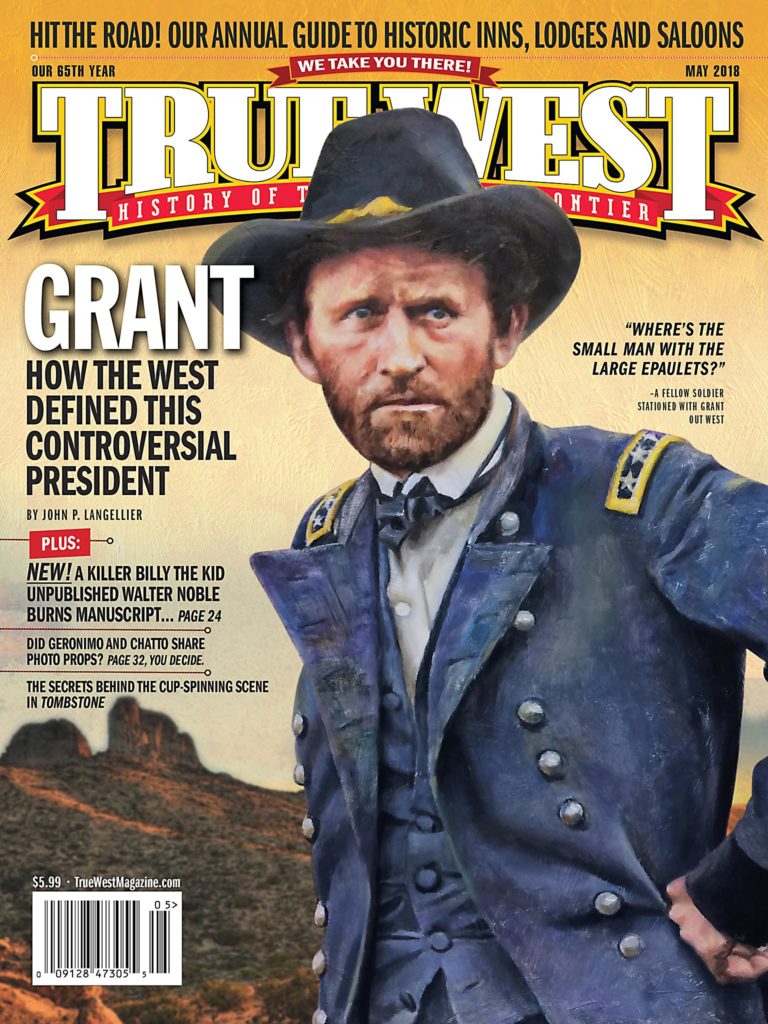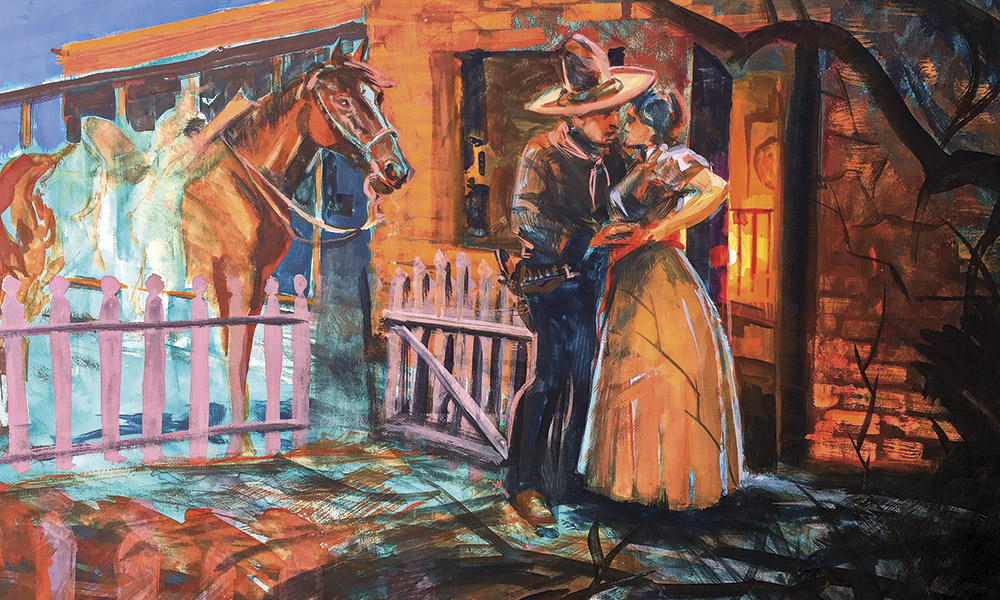
— Illustration by Bob Boze Bell —
Walter Noble Burns was onto something. A 56-year-old Chicago journalist, Burns had become intrigued by a long-dead and largely forgotten outlaw named Billy the Kid. He suspected the Kid’s bloody career might make a good story. So, in the summer of 1923, Burns traveled to far-off New Mexico, hoping to find and interview old-timers who had known the gunslinger.
The three-month trip could not have gone better. Burns located several of the Kid’s associates and thrilled at their vivid and stirring reminiscences. Perhaps his biggest catch was Paulita Maxwell Jaramillo, a woman whom several informants singled out as the Kid’s lover and the sole reason for the outlaw’s fateful return to Fort Sumner after his notorious Lincoln County jail escape in the spring of 1881.
Soon after Burns returned to Chicago, he completed two articles based on his New Mexico interviews. One told the story of the Lincoln County War, primarily through the words of Susan McSween Barber, whose first husband, attorney Alexander McSween, was one of that deadly feud’s protagonists.
The second article focused on the Kid’s final exploits. It was also the story of Jaramillo, who narrates the Kid’s tale. Burns titled the article, “A Belle of Old Fort Sumner.”
Curiously, Burns’s two articles never appeared in print. A likely explanation is that Burns realized he had the makings of a book; he submitted a book proposal on the Kid to Doubleday, Page & Co. in October 1923. Three years later, his seminal The Saga of Billy the Kid appeared, becoming an immediate bestseller and making the Kid a household name for all time.
What of those two articles? Burns recycled much of the information for his book, but he wrapped the article typescripts in brown paper, tied the package with a string and stored them away. There they remained until a cache of Burns manuscripts surfaced in an online auction in 2017.
Because Burns’s New Mexico interview notes do not seem to have survived, these articles, with their long quotations and written while these tales were still swirling in his mind, may be the closest we will get to the actual words said by Barber and Jaramillo—and perhaps even the words said by the Kid.
In the article published here, Burns gives us Jaramillo’s version of the Kid’s Lincoln jail escape, which she claimed as the “true one.” Yet she wasn’t even in Lincoln at the time, so where did she get her account? Only the Kid would have known some of the details she relates. On the other hand, Burns may have created a fiction, using Jaramillo to tell the story as a literary device. Scholars have long questioned Burns’s quoted material in his Kid biography, surmising it contains a good deal of embellishment. (The only changes made are fixing typos, adding paragraph breaks, clarifying punctuation and correcting names to conform to accepted spellings.)
A keen-eyed reader of both The Saga of Billy the Kid and the following article will find thought-provoking discrepancies, raising more questions that cannot be easily answered. Even so, Burns was a masterful storyteller, and his first crack at writing the Kid’s story provides us with a fascinating look at the beginnings of a true epic.
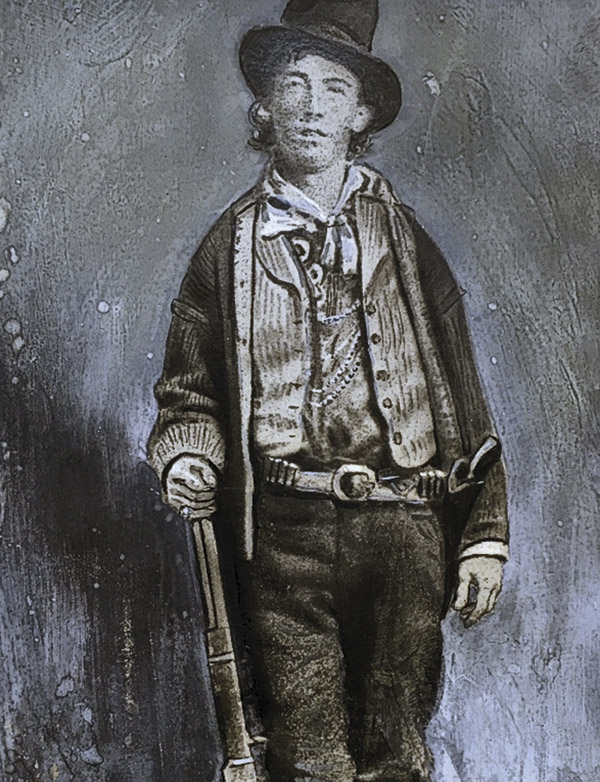
— Courtesy Mark Lee Gardner —
Sheriff Pat Garrett and Billy the Kid were contemporaries in one of the most dramatic periods of New Mexico’s history.
Garrett was a brave and efficient officer. He was the kind of man the times and the country needed. When he became sheriff of Lincoln County, the county was the most lawless section of the Southwest. Most of the men of the country lived by the six-shooter, and many died by it. The trigger finger was judge, jury and executioner.
When Garrett retired from office, Lincoln County was as peaceful as a New England countryside. He wiped out one of the most desperate bands that ever set law at defiance. That was his job, and though he took his life in his hands when he undertook it, he finished the job in workmanly and thorough style. Once he had taken the trail, he followed it remorselessly to the end, and when he had reached the end, every member of the band was dead, in prison or had been run out of the country. The establishment of law and order west of the Pecos was due to this fighting, relentless officer more than to any other one man.
Billy the Kid was an opposite type. He stood for lawlessness as Garrett for law. He was distinguished as a killer and desperado in a day of killers and desperadoes. He marked out a trail of blood as a fighter on the McSween side against the Murphy faction in the Lincoln County War, the bloodiest vendetta of border history. He became later the leader of a band of outlaws that terrorized New Mexico Territory. How many men this precocious genius in homicide sent to their graves probably will never be accurately known.
When Pat Garrett snuffed out his life at Fort Sumner, Billy the Kid was twenty-one years old and is popularly supposed to have killed twenty-one men—a man for every year of his life.
Both Billy the Kid and Sheriff Pat Garrett made history in New Mexico. One brought opprobrium on the territory, the other deserved the state’s undying gratitude. But go into New Mexico today, and you will find a paradox. Everywhere you will hear Garrett disparaged or damned with faint praise. He was “cold-blooded and heartless.” He was a “coward.” He was “friend to no man.” He wiped out Billy the Kid and his gang—yes—but he did it from “mercenary motives for the blood-money rewards offered on the heads of old friends.”
You will find, on the other hand, Billy the Kid held in affectionate memory. His crimes are minimized or forgotten. A halo has been placed about his scapegrace brow. His courage, generosity, loyalty are extolled. He was engaging, devil-may-care, lighthearted, just a boy, more sinned against than sinning, a scapegoat for the misdeeds of others. Men still admire him; women sing his praises and lament his fate. An anthology of ballads and border poetry has grown up about him. Tradition has clothed him with glamour as a hero. He has become a figure of eternal youth riding through eternal romance.
So the years have played strange tricks with the fame of these two, begrudging just honor to the champion of law and bestowing sympathy and admiration on the outlaw, evolving from myth, false romanticism and underdog psychology one of fate’s classic satires.
If you drop in any pleasant day upon Fort Sumner, New Mexico, a little town that has grown up in the last few years five miles from the site of Old Fort Sumner, you will perhaps find Mrs. Paulita Jaramillo in a comfortable rocking chair on the rose-embowered porch of her little cottage. How old the lady is it were not gallant to inquire, but it may be whispered discreetly that she was a blooming girl of eighteen in 1881 when Pat Garrett killed Billy the Kid in her home. She still has claims to comeliness. Her dark hair is only lightly streaked with gray, her face is of olive smoothness and her black eyes have a sparkle that age has had no power to dim.
It is easy to fancy her the dashing beauty she is said to have been when she was the belle of Old Fort Sumner and the toast of hard-riding cavaliers of all the cattle ranges from Santa Rosa, Puerto de Luna and Anton Chico to Roswell and Seven Rivers and from the Upper Pecos to Rio Peñasco. She knew on terms of intimate friendship Pat Garrett, Billy the Kid and the men who rode and fought with them, and if you chance to be interested in stories of the kind, she can thrill you with tales of personal experiences in frontier days whose drama was the background of her early life.
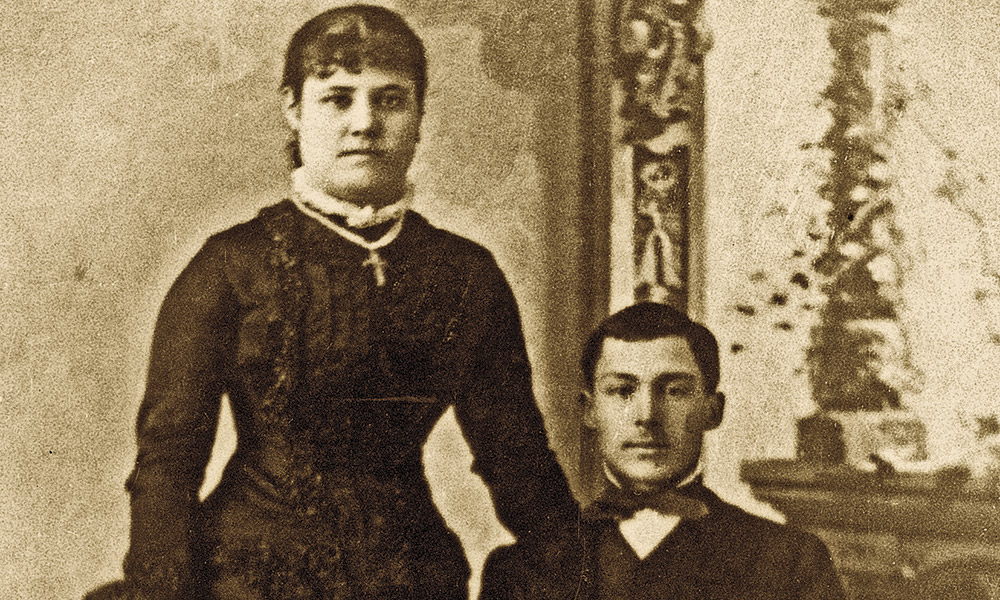
— Courtesy Frederick Nolan —
Mrs. Jaramillo is the daughter of a family distinguished in the early annals of New Mexico. When Lucian B. Maxwell, her father, a native of Illinois, settled in New Mexico, it was still a province of Mexico. He married Luz Beaubien, daughter of Charles Hipolyte Trotier, Sieur de Beaubien, a Canadian of noble lineage, and a pioneer Santa Fe Trail trader who reached New Mexico in 1823, and of Paula Lobato, of an old Spanish family. With Don Guadalupe Miranda, Beaubien obtained from the government of New Mexico a grant of land of vast extent in the northern part of the province, afterwards famous as the Maxwell grant. Miranda sold out his interest to Beaubien and, upon the latter’s death in 1864, Maxwell through purchase from the heirs became the sole owner of a tract larger than three states the size of Rhode Island and embracing more than a million acres. The land today is dotted with towns, cities and mines and is worth at a modest estimate $50,000,000.
Maxwell built a veritable palace at Cimarron where for years he lived in a style of baronial magnificence. Traders who freighted merchandise over the old Santa Fe Trail which passed his door, descendants of the pioneer hidalgos, cattle kings, governors, army officers and distinguished men of America and Europe enjoyed his hospitality. His cellars were filled with champagne and costly vintages, his tables were laid for two dozen guests a day and the viands were served in dishes of solid gold and silver.
Owner of great herds of sheep and cattle, founder of the First National Bank of Santa Fe, this feudal lord of the old frontier finally sold his lands for the reputed sum of $750,000, lost a large part of his fortune in unfortunate investments and retired to Fort Sumner where he died in 1875.
But aside from her father’s spectacular career, Mrs. Jaramillo has a picturesque interest of her own. This daughter of a famous house has the name throughout New Mexico of having been Billy the Kid’s sweetheart. You hear the story everywhere. Frank Coe, who fought with Billy the Kid in the Lincoln County War; Mrs. Susan E. Barber of White Oaks, widow of Alexander McSween, leader of one of the factions in that deadliest of border vendettas; Mrs. Sallie Roberts of Roswell, niece of John Chisum, famous cattle king of the Pecos; Martin Chaves, Nicholas Seña, Yginio Salazar, Miguel Luna and most of the old-timers, whose memories hark back to the old days, still roll the romantic legend over their tongues.
Mrs. Jaramillo’s neighbors in Fort Sumner repeat the tale and add that she and Billy the Kid planned to elope on horseback to Mexico on the night following that on which Billy the Kid was killed. You will hear at Las Tablas, a little village in the foothills of the Capitans through which the Kid passed after his celebrated escape from Lincoln, that he said to an old Mexican, “I am going to Fort Sumner to see my sweetheart if it costs me my life.”
So when you meet Mrs. Jaramillo, you are keen to hear the details of this old romance. But Mrs. Jaramillo declares quite positively the story is a fable.
“That old story,” she said, “has been going the rounds for more than forty years, but it is not true. Billy the Kid and I were good friends, and that was all. If I had loved him and he had wanted me, I would have married him no matter what he had done or what the world might have thought. But neither of us ever dreamed of love or marriage, and the story of our planned elopement is absurd.
“Strange as it may seem, Billy the Kid fascinated many women and his record as a heartbreaker was as formidable as his record as a mankiller. He numbered his queridas by the dozen, and in almost every little town and placita, some black-eyed girl was proud to be known as his light o’ love.
“I know of one woman of wealth still living in New Mexico who ate out her heart for love of him. He had at various times three sweethearts in Fort Sumner. One of them, I am told, is now a respected matron in Las Vegas. Another had a daughter who lived to be eight years old, and whose striking resemblance to the famous outlaw filled the mother’s heart with pride. The third and last was the lure that drew him to his death. But it is just as well to let those old scandals sleep. The mention of names, even at this late day, might stir up a hornet’s nest.”
So, as far as this old sweetheart story is concerned, that’s that, as the phrase goes.
“I remember,” Mrs. Jaramillo said, “the first day Pat Garrett ever set foot in Fort Sumner. It was in February 1879, and he came to our home to ask Pete Maxwell, my brother, for a job as a cowboy. He was fresh from the Texas Panhandle where he had made a living hunting buffaloes. I was a little girl and stood behind my brother on the porch with my finger in my mouth and stared at him. He was the tallest man I had ever seen and had the longest funniest legs. His clothes were worn and weather-stained, and the queerest part of his make-up was a pair of hairy buffalo-skin leggings. But this scarecrow man had a twinkle in his gray eyes and good humor in his drawling voice, and he smiled his way into a job. He worked on the range for my brother until Pete had a disagreement with him and discharged him.
“After that, Garrett opened a restaurant in Fort Sumner and later went into partnership with old Beaver Smith in a store and saloon. He liked a social glass and was a great hand to play poker and monte, and the men used to like to play with him because he usually lost. Pete and he made up their differences, and, many an evening, Garrett spent in our home, spinning yarns about his adventures on the buffalo ranges. He was a freehanded, easygoing sort of man, and everybody liked him.
“Billy the Kid and his band were at the height of their career as outlaws then. They made Fort Sumner their headquarters and were in town and gone again every little while, usually with their pockets full of money.
“Garrett became good friends with all those fellows—Charlie Bowdre and Tom Folliard, who lived in Fort Sumner, Jim French, Billy Wilson, John Middleton, Henry Brown, Doc Scurlock, Dave Rudabaugh and the rest. He ate and drank and played cards with Billy the Kid, went to dances with him and gallivanted around with the same Mexican girls.
“I have seen them both, more than once, down on their knees around a blanket stretched on the ground in the main street, gambling their heads off, as they say, against a monte game. If Pat went broke, he borrowed from Billy, and if Billy went broke, he borrowed from Pat.
“Sometimes they engaged in friendly shooting contests. Both were crack shots. It was a toss up between them when it came to the rifle, but the Kid was the better shot with the revolver. He was a six-shooter specialist and, at quickness in drawing his weapon and at the same time shooting accurately, no man in the country was his equal.
“The point I am making is that in those days, the two were as thick as peas in a pod. There was probably not a man in Fort Sumner whom the Kid regarded as a better friend than Pat Garrett.
“I knew all these boys well. Fort Sumner was a gay little place socially. It had been a frontier army post—abandoned in the sixties—and had a gay tradition. The weekly dance was an event, and the pretty girls from the ranches and towns fifty miles away rode in to attend it. In the code of those days, any man who was courteous to women was considered a gentleman, and no questions asked, and as there was no law to speak of in the country, an outlaw who lived up to this simple standard, was as welcome at Fort Sumner’s social affairs as anybody else.
“Billy the Kid, let me tell you, cut quite a gallant figure at these jolly dances. With his smiling boyish good looks and easy debonair bearing, he was in great favor as a cavalier, and the little Mexican beauties made eyes at him from behind their fans and brought into play all their arts of coquetry to capture his attentions. Billy was polite and good-natured, not afraid of anybody and talked Spanish like a Mexican.
“It makes me sad nowadays when I drive out from New Fort Sumner to the scene of these frolics and merry-makings of my girlhood. Old Fort Sumner is a town that was. Not a single house is left standing. Grass-grown mounds mark the foundation walls of my old home and outline the room in which Billy the Kid was killed. The famous twin rows of giant cottonwoods that once formed a shady boulevard five miles long show ragged gaps. The bronze-red waters of the Pecos have eaten away much of what was the main street. Jackrabbits scuttle over the old parade ground, a favorite lovers’ walk in the old days. The peach orchards that framed the village in pink blossoms in the spring have disappeared. I must take my memories with me when I go there. Nothing is left on the level, desolate waste of wild grass and weeds to remind me of the picturesque and lively town I once knew.
“Garrett married twice during his residence of more than two years in Fort Sumner. Juanita Martinez, his first wife, died a few weeks after the wedding. His second wife, Apolinaria Gutiérrez, now his widow, is still living in Las Cruces. Shortly after his second marriage in 1880, Garrett moved to Roswell and was elected by John Chisum and the cattle interests sheriff of Lincoln County.
“Chisum, at that time, was the largest individual cattle owner in the Southwest or in the United States, for that matter. He had been a friend of Billy the Kid during the Lincoln County War and had supported the McSween faction, with which the Kid fought. But the Kid later had turned cattle rustler, and Chisum’s herds had suffered from his raids. The hour had come when, for his own business interests and the future of the territory, lawlessness must be suppressed, and Chisum found the man for the hour in Pat Garrett.
“Garrett’s selection to be sheriff was a surprise in Fort Sumner. He was practically unknown. He had no experience as a manhunter and no reputation as a fighter. But for the purposes of Chisum and the cattlemen, he had one qualification that outweighed everything else. That was his old-time friendship for Billy the Kid and his followers. This had given him a familiar knowledge of all their old trails, their favorite haunts and their secret places of rendezvous and refuge.
“The one big thing Garrett was called on to do as sheriff was to hunt down these old friends. I do not say this with malice, but merely as a fact. There is no law against a man’s making new friends or turning against old ones, and if we remember that Garrett had been a friend of outlaws, we must not forget he had never condoned outlawry. He assumed office with the philosophic attitude of a poker player who, when he puts his legs under the table, declares, ‘Here’s where friendship ceases.’ Certainly, he was outspoken and frank about what he proposed to do. When he became sheriff, Billy the Kid knew exactly what it meant. From that time on, it was war to the death between them.
“Tom Folliard was the first to die. Garrett had word the Kid was coming into Fort Sumner to attend a big Christmas dance. This was in 1880. With a posse of fifteen men, Garrett rode into town. They put up their horses in my brother Pete’s barn and hid themselves in the old military hospital commanding the road by which the Kid was expected to come. While waiting for the outlaws, Garrett, Barney Mason, Tom Emory and Bob Williams whiled away the time playing poker.
“About eleven o’clock at night, one of their sentinels ran in with the announcement that Billy the Kid was coming. They rushed out to see five horsemen approaching through the darkness. ‘Hands up!’ shouted Garrett.
“Four of the riders wheeled and galloped off in a shower of bullets from Garrett’s men. Folliard, mortally wounded, cried, ‘Don’t shoot any more. I’m killed.’ He slid from his saddle into the arms of Garrett and Mason as they ran up.
“I heard all this as my mother and I were sitting at home, and ran up on our upper porch to see what I could see. It was a cold, perfectly still, moonlight night with snow on the ground. I could see the crowd of men in the road. Folliard had begun to scream curses on Garrett’s head. I heard Barney Mason say: ‘Be game, old boy. Take your medicine like a man.’
“They carried the dying man inside. For a long time I could still hear his muffled groans and curses. Then his voice began to grow fainter, and, at last, there was silence. Mason said afterwards that he and Garrett and the others went back to their card game and played calmly while Folliard breathed his last on a blanket in a corner, and for several hours after he was dead.
“They buried the dead man in the little military cemetery near town next day, and Garrett and his posse struck north to round up the others. The four who had escaped were Charlie Bowdre, Billy Wilson, Tom Pickett and Dave Rudabaugh. Billy the Kid had been with them until within a mile of town, but for some crafty reason of his own, had left them to ride in alone by another road. He had heard the firing and joined the others as they spurred their horses on the back trail.
“The fugitives took refuge in an old stone house on Arroyo Tiban twenty miles from Fort Sumner. There, Garrett’s posse surrounded them. When dawn came, Garrett and three others lay in ambush in a ravine thirty feet from the door. Bowdre stepped out with a moral in his hand to feed his horse. He had on Billy the Kid’s hat, and Garrett, in the dim light, thought he was Billy the Kid. He and ——- ——— shot him. Bowdre ran back inside fatally wounded. The posse heard Billy the Kid say, ‘You are as good as dead, Charlie. Go out and see if you can’t kill one of those fellows.’ Dying, Bowdre obeyed orders. He staggered outdoors. He murmured, ‘I wish—I wish.’ Then he fell dead.
“Garrett and his men killed the band’s horses tethered in front of the house. That took away the only chance of escape. Cold, hungry, worn out, the Kid surrendered late in the afternoon. Garrett brought his four prisoners, with Bowdre’s body lying in a wagon, into Fort Sumner. When they carried the corpse into his old home, Manuela, his widow, went crazy with grief and knocked down one of the possemen, Jim East, with a branding iron. Bowdre was buried beside Folliard. The row of graves was growing.
“The Kid was tried in March in Mesilla for the murder of Sheriff William Brady in the Lincoln County War and sentenced to die on the gallows on May 13. While awaiting execution, he was held in an upper room in the courthouse at Lincoln under close guard by Deputy Sheriffs Bob Olinger and J.W. Bell. Steel manacles on his wrists and ankles were never removed. He ate and slept with them on. His case seemed hopeless.
“Olinger was himself a desperado. He was said to have killed three men. In the old feud, Olinger had fought with the Murphy faction and the Kid on the McSween side. The Kid had killed Bob Beckwith, one of Olinger’s best friends, and Olinger had hungered and thirsted for vengeance. There was deep and bitter enmity between them. Olinger hated the Kid, and the Kid hated him.
“Nothing gave Olinger such joy as to heap insults on the Kid and throw taunts in his teeth. ‘Well, Kid,’ he would say every morning, ‘you are one day nearer the gallows.’ He loaded a shotgun before the Kid’s eyes with nine buckshot in each barrel. ‘Try to get away, Kid,’ he jeered, ‘and you will get eighteen buckshots between your shoulders.’
“Billy laughed. He kept up a constant unruffled show of cheerfulness and good humor. He told funny stories; he cracked jokes. His two guards began to think he was resigned to his fate. But they misjudged their man. The Kid was never so dangerous as when he smiled. He was the kind that never gave up hope. With him, no game was lost until the last card had been played. All the time, he was watching with the alert patience of a panther for his opportunity. When it came at last, it was one chance in a million.
“There are many versions of what happened. I’ll tell you the true one. At noon one day—it was April 28—Olinger went across the road to the old Murphy hotel for dinner, leaving Billy alone with Bell.
“Billy seemed in high spirits. ‘Well, amigo,’ he said to Bell, ‘only a few more days left for me. Let’s have a game of monte.’ Bell, who was a good hearted man, agreed just to humor him. He dealt out the cards on a table. Billy, sitting on the edge of the table with his hands and legs still manacled, bucked the bank. He joked and laughed as he played.
“Suddenly as if by accident he knocked a card on the floor. Bell reached down to pick it up, and, when he straightened up with the card, he was looking into the muzzle of his own six-shooter that Billy had snatched from its scabbard.
“‘I don’t want to kill you, Bell,’ Billy said. ‘You have been good to me. Step into that next room and I will lock you up.’ But Bell turned and ran out the door, and Billy killed him as he started down the stairs. The hole made by the bullet that passed through Bell’s heart is still in the wall in the old courthouse.
“Hearing the shot, Olinger came running across the road. Billy caught up the shotgun that Olinger had loaded with buckshot for Billy and stepped to a window. When Olinger was just beneath him, Billy stuck his head out and said quietly, ‘Hello, Bob.’ As Olinger looked up, Billy riddled him with both barrels. Then he threw the gun crashing down on his body. That was probably the happiest moment of the Kid’s life.
“Billy armed himself with two six-shooters and a Winchester which had been kept in a room known as the jail armory, hobbled downstairs and, stepping over Bell’s body, went out a back door. He made old man Gauss, the jail cook, file the chains that held together the steel cuffs on his wrists and legs. Then he ordered Gauss to catch a pony in the jail pasture and saddle it for him. All this took more than an hour.
“None of the townspeople came to investigate. They guessed what had happened and stayed discreetly in their homes, leaving Lincoln’s one street silent and deserted. And all the while, Billy was as cool, Gauss said, as a boy eating apples. ‘Goodbye, old man, take care of yourself,’ he said cheerfully as he swung himself on the pony. He rode out of town in an easy gallop, his rifle across his saddle bow, whistling a little tune.”
Mrs. Jaramillo paused in her epic story. She took occasion to comment that it was foolish for Billy the Kid, escaped from the shadow of the gallows, to go to Fort Sumner where he might have known Garrett would hunt for him the first thing. He should have headed for the Mexican border, she said, once across which he would have been safe.
“But to Fort Sumner he rode, as straight as a bird can fly,” she continued, “to see his sweetheart and to meet his fate. Garrett heard he was in hiding there.
“On the night of July 14, Garrett came to Fort Sumner with two deputies, Kip McKinney and John W. Poe, later to become a man of wealth and influence and who died a few months ago president of the Citizens’ National Bank of Roswell. They hitched their horses in a peach orchard at the edge of town and stole through the streets in the shadows of the houses to our home. Poe and McKinney sat on the edge of the porch while Garrett stepped into Pete Maxwell’s bedroom to question my brother about the Kid’s hiding place.
“The Kid at that moment was not more than thirty yards away in the house of Saval Gutiérrez, Garrett’s brother-in-law. He had come in a few moments before from a sheep camp. Tired and hungry, he took off his boots, coat and hat and, flinging himself down on a bed, asked Celsa Gutiérrez, Saval’s wife, to cook him something to eat. Celsa said she had nothing but tortillas and coffee, but gave him a butcher knife and told him to go to Pete Maxwell’s house and cut some meat from the carcass of a beef butchered the day before and hanging on the north porch.
“So bare-headed, hatless, coatless, with the butcher knife in his hand and his 41-caliber revolver in his belt, Billy started across a little open space to our house. Concealed behind a little paling fence, Poe and McKinney saw him coming through the moonlight. They thought he was one of Pete’s sheepherders.
“When the Kid opened the gate and stepped on the porch, he almost stumbled over the two deputies. Out came his gun as quick as a flash. ‘Quien es?’ (Who are you?) he asked, covering them. ‘Needn’t be afraid,’ Poe said to the supposed sheepherder. ‘Nobody’s going to hurt you.’ The Kid, keeping his revolver leveled, backed across the porch into the open door of Pete’s room.
“The room was dark. Pete lay in bed in a corner. Garrett sat at the head of the bed in a chair against the wall. Coming in out of the bright moonlight, the darkness for a moment blinded the Kid. He stepped to the side of the bed so close to Garrett he could have touched him and said to Pete, ‘Quien es son esos afuera?’ (Who are those fellows outside?) Pete did not answer.
“The Kid caught a sudden glimpse of Garrett’s shadowy figure. He sprang back quickly and covered Garrett with his gun. ‘Quien es?’ he said.
“Garrett answered with his six-shooter, and the Kid fell dead in the middle of the floor with a bullet through his heart.
“I was asleep in an upper room and was awakened by the noise. I rushed downstairs to the porch where I found Garrett, Pete and the two deputies standing in a hushed, excited group. Not a sound came from the room. But no one would venture in for fear the Kid might not be dead. If only a spark of life were left, he might be dangerous.
“I brought a lighted candle and, keeping in the shelter of the adobe wall, reached out an arm and placed the candle in the windowsill. It lighted the inner darkness dimly. My brother took a furtive peek through the window and saw the Kid lying on his face motionless. ‘Now, Pat, you can go in,’ Pete said. ‘He’s dead.’
“They carried the body into a deserted storeroom, full of dust and cobwebs, and laid it on an old work bench. The town was aroused by now, and Mexican men and women crowded in. When they saw the Kid lying dead, the moon shining on his face through a window, the women broke into frenzied tears, filling the place with their shrieks. Celsa Gutterrez screamed as one demented. Nasaria Yerbe was wild with grief. Abrana Garcia, shaking her clenched fists aloft, called down curses on Pat Garrett’s head and threatened to kill him. Deluvina Maxwell, [an] old servant of our family whom my father had bought from the Navajos when she was a little girl, and to whom the Kid always had been a hero, burst into hysterical lamentations. She threw her arms about the Kid and covered his face with her tears. ‘Mi muchacho, mi muchacho,’ she wailed.
“Francisco Medina knocked together a box of rough pine board next day to serve as a coffin; the hearse was a rickety old wagon drawn by scrawny ponies. Practically every man, woman and child in town followed the body to the little cemetery. You might have thought the funeral that of Fort Sumner’s most distinguished citizen. They buried the Kid next to Bowdre and Folliard. His grave was at one end of the row, Folliard’s at the other and Bowdre’s in the middle. At the head, they set a little wooden cross on which had been painted ‘Billy the Kid’ in crude, zigzag letters.
“The cemetery then had an adobe wall around it. Now a barbed-wired fence surrounds its dreary half-acre of sun-baked land sparsely covered with bunch grass and desert growths. Twelve men who died with their boots on in Fort Sumner are buried there. One was Joe Grant killed by Billy the Kid in the saloon of José Valdez. The cross over the Kid’s grave was shot away by half-drunken soldiers in the eighties and never has been replaced. The Kid and his two comrades and the murdered men all asleep in unmarked graves.
“Charlie Foor who has lived in and around Fort Sumner for forty years and two or three others are all that are left in this part of the country who can point out the Kid’s grave. Step thirty feet straight south from the gate, and you find a spot of hard yellow earth across which cactus and salt grass have woven green patterns. That is Billy the Kid’s last resting place. Likely as not, as you stand there in a mood of reverie, a mockingbird, winging from the river pastures, will alight upon a fence post and sing a song in the sunshine.
“Looking back at the old tragedy,” Mrs. Jaramillo went on, with the air of one adding a footnote, “the Kid’s last night on earth seems to have been a night of blunders.
“Poe and McKinney could have killed him when, unseen themselves, they saw him walking toward them in the moonlight. They did not kill him because they believed him a harmless sheepherder.
“The Kid could have killed Poe and McKinney when he had them covered with his revolver. His suspicions were acutely aroused, but he did not kill them because, it is evident, he did not want to murder men whom he had a vague idea might be only Pete Maxwell’s friends.
“The Kid could have killed Garrett. When he threw down the weapon on the shadowy form in the darkness, Garrett would not have had a chance if the Kid had fired. But it seems clear that the same dubious thought that saved Poe and McKinney saved Garrett. Fear that Garrett might be another friend of Pete Maxwell’s still held the Kid’s trigger finger from deadly action. It would have been more like the Kid’s true self if he had shot first and investigated afterwards. But, perhaps for the first time in his life, he wavered irresolute for an instant, and his instant’s hesitation was fatal.
“If Garrett had spoken, the Kid would have recognized him by his voice. If Garrett had risen, the Kid would have recognized him by his height. In either case, Garrett would have been the man to die. But Garrett did not speak, did not rise, did not hesitate. He alone made no mistake.
“The Kid did not fire a shot. Any story to the contrary is false. It is safe to say that in his last flash of consciousness, he did not know who shot him.
“Garrett fired a second shot before he rushed out of the room on the heels of Pete Maxwell. Garrett did not know, and nobody else knew, until four years afterwards where his second bullet went. Then we accidentally found it embedded in the underside of the top of the washstand.
“When Garrett silently slipped his six-shooter from its holster, he dropped over sideways from his chair as he fired his first shot. From the angle his second bullet struck the washstand, it must have been fired almost from the level of the floor. It missed the Kid by six feet. It suggested a panic.
“But a panic in that desperate crisis might have been pardoned even in a brave man.”
Mark Lee Gardner is the author of To Hell on a Fast Horse: The Untold Story of Billy the Kid and Pat Garrett and other books. He is currently working on a dual biography of Crazy Horse and Sitting Bull.

